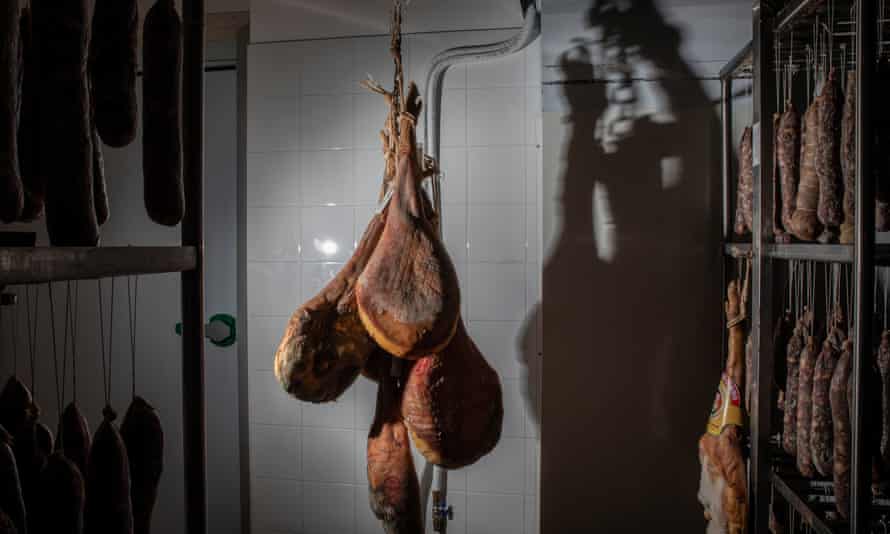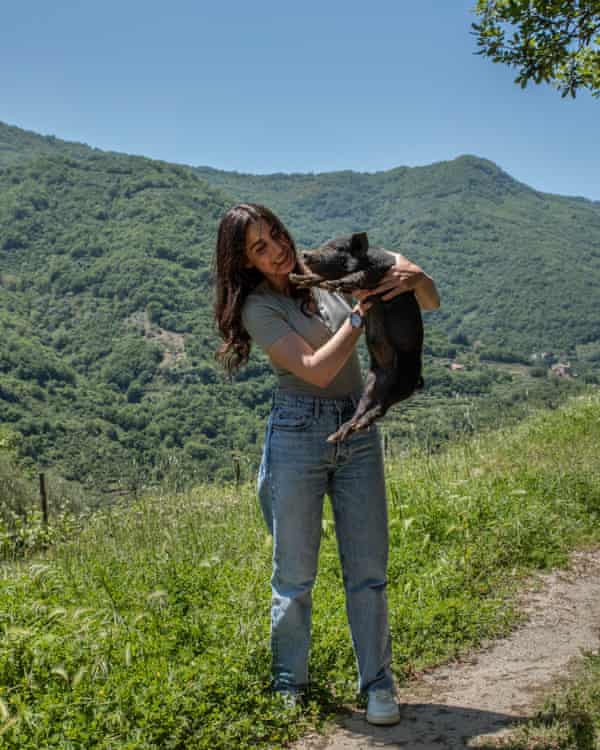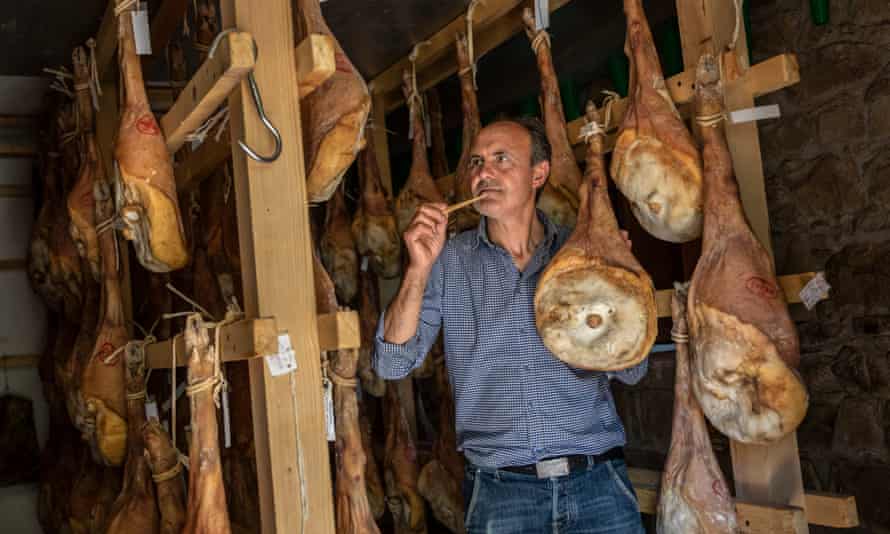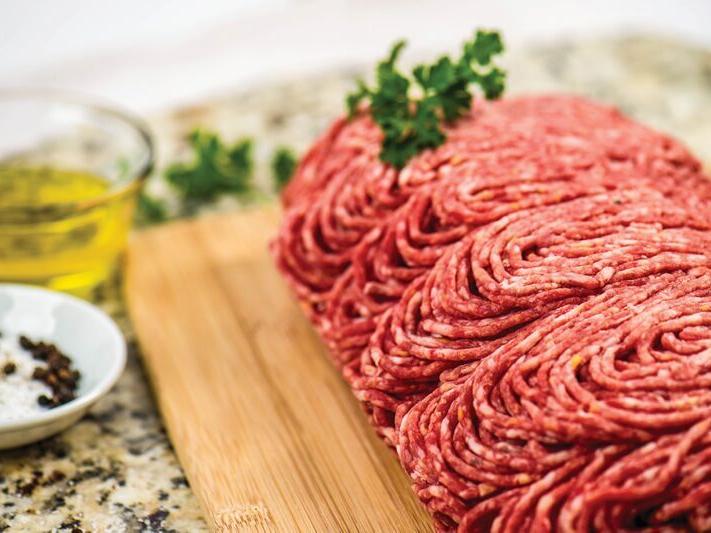F
ranco Borrello’s black pigs roam freely in the bucolic foothills of eastern Sicily, where they graze and forage for acorns and wild roots in his 40 hectares (99 acres) of oak forest. Every year he loses several of them, as these ancient breeds of domesticated Sicilian pigs often sneak out from the metal enclosure.Franco, 56, doesn’t care that much. “They practically live in the wild,” he says. “And it’s a price we’re willing to pay.”
But it’s a price that, today, a rising number of pig farmers in the country can no longer afford. According to data analysed by the Guardian, the number of pig farms in Italy dropped by 76% between 2005 and 2016, even though the number of pigs has remained relatively constant. Almost 90% of Italy’s estimated 12 million pigs are reared on intensive farms.
When Franco began rearing the black pigs about 40 years ago, the breed, similar to wild boars, was nearly extinct.
“It is a prized breed of pig,” says Franco’s daughter, Annalaura, 25, who manages the family business with her father and brother, Giuseppe, 21. “Their meat contains high levels of HDL, the so-called good cholesterol, which plays an important role in human nutrition.”

Thanks to Sicilians’ rediscovery of the black pig, which roamed the Nebrodi mountains in north-eastern Sicily and whose fossilised remains dating back to the eighth century BC have been found on the island, the Borrello family slowly began to build their farm in Sinagra, one pig at a time, following environmentally sustainable practices.
From a distance, the Borrellos’ farm – nestled among the lush green hills of Sinagra and crossed by the Naso River – looks like something straight out of Hobbit Shire, with dozens of stone structures that resemble small homes.
“They’re called zimme,” says Annalaura. “They’re ancient constructions for pigs that we’ve reconstructed because they have a low environmental impact.”
While most of the pigs are left in the wild, others, especially sows with their piglets, are kept in large outdoor enclosures, each with a zimma, which is built using poles arranged in a circle that converge at the top to form a cone. Then they are clad with stones, earth, a layer of Mediterranean broom and ferns. They are cool in the summer and warm in the winter.
“Our pigs are antibiotic-free,” says Franco. “Besides acorns and fruit, we use a particular fodder that is first immersed in water. The sprouts that form aid the animals’ digestion. We keep the animals for quite a long time. In most cases, we do not slaughter them under two years of age. Obviously, all of this comes at a relatively high cost that can’t compete with the price of pork from industrial-scale farms.”

Pork is an important part of the Italian diet and features in many culinary traditions of a country famous for its sausages, porchetta, salami, and prized cooked and cured hams.
Most farms are in northern Italy, almost half in the Lombardy region, particularly in the province of Brescia, where nearly 1.3 million pigs outnumber 1.25 million humans.
The market appears heavily skewed against smaller-scale pig farmers competing with large-scale pork producers.
“The production of pork in Italy is one of the most divided industries in the world,” says Fabio Ciconte, director of the environmental organisation Terra. “In this sector, there are no consortiums that enable small and principled producers to join in large-scale distribution. Niche producers offering sustainable farming practices survive haphazardly with the sale of their products to restaurants or small shops, or they sell their live animals. They’re cut off from the dominant market.
“The vast majority of industrially raised pigs are designated for protected designation of origin products, such as Parma ham and prosciutto di San Daniele, two flagship products that totally exclude the participation of small-scale breeders.”
The risk is that enterprises such as the Borrellos will slowly succumb to the pressure, leaving a market monopolised by industrial farms.

Covid has further complicated the survival of Italy’s small pig farms. Since the beginning of the pandemic, consumption of cold cuts has increased by almost 9%, according to the Italian Agri-Food Industry Institute. Italian families, forced to stay at home during lockdown, have consumed more ham, sausages, salami and lard than usual.
“The pandemic has further damaged small pig farms that survived thanks to restaurants buying their products,” says Franco, who produces salami, lard, fresh meat, and cured and cooked ham, and recently opened his own restaurant. “On the other hand, the coronavirus emergency has increased the turnover of large companies.”
Franco is still managing to survive, thanks to delicatessens specialising in niche products. But many of his colleagues are struggling. In recent years, many small farms have given up and sold their animals cheaply to large companies because they could not keep up with the competition.
“It could soon be the end for Italian small pig farms,” says Franco. “Their survival is not the only thing at stake here. Our health depends on the welfare of these animals. And if I have to judge the welfare of a pig in an intensive farm, then our future is far from bright.”
Sign up here for the Animals farmed monthly update to get a roundup of the best farming and food stories across the world and keep up with our investigations. And you can send us your stories and thoughts at animalsfarmed@theguardian.com
The Link LonkMay 24, 2021 at 05:00PM
https://ift.tt/3oVrE2t
Sicily’s prize pigs: can niche farms hold out against mega pork? - The Guardian
https://ift.tt/2RsHZwT
Pork

No comments:
Post a Comment